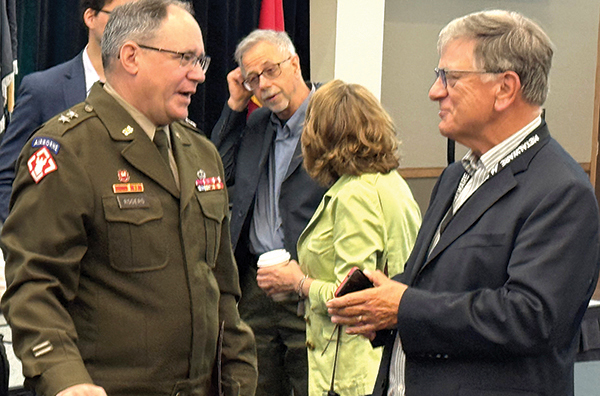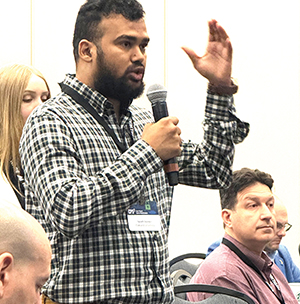
Imagine, if you will, a scenario where the U.S. is locked in a confrontation with China. A U.S. soldier is about to deploy. The night before he’s scheduled to leave, he wakes up to hear his daughter crying. Thinking she’s upset about his impending deployment, he goes to her room to comfort her.
Then he hears the Alexa system in the house tell her that her father “is going to die.
“He’s attacking China,” Alexa says. “China’s a peaceful country and he deserves to die because of what he’s going to do. And then we’re going to come kill your mother. We’re going to come kill your sister.”
In the morning, he has to leave for his deployment, but neither his nor his wife’s car will start. He calls for a ride, and goes back into the house, where his wife and daughters are furious, because they’re looking at compromising photos on social media.
They discover, to their dismay, that the photos were taken from their own internal security system. They later discover their bank accounts have been drained. His deploying unit discovers that a shipment of equipment they’d sent somehow ended up at the Canadian border. He gets a text from his wife that the power is out at their home and there is no heat.
Farfetched? Maybe so. Then again, in this day and age of cybersecurity threats, maybe not.
You don’t have to imagine the scenario, because U.S. Army Major Timothy Dwyer did it for you, in a piece of fiction he wrote in 2021 for The Army University Press Future Warfare Writing Program, designed to generate ideas about possible complexities of future warfare as presented in the Army Operating Concept (read the fictional piece at: https://www.armyupress.army.mil/Journals/Military-Review/English-Edition-Archives/September-October-2021/Dwyer-American-Maginot-Line/).
Maj. Gen. Paul Rogers, who allows as how he’s not the foremost expert on cybersecurity, used the story to open his presentation at the National Defense Industrial Association Michigan Chapter’s 10th Annual Cyber-Physical Systems Security Summit at Oakland University.
While he acknowledges he’s not the world’s best expert, he knows plenty enough to know how big a challenge it is, both in the business world and in military circles. Rogers asked attendees to imagine the repercussions if Dwyer’s doomsday scenario actually happened.
“Think about all of those consequences, and think if you were in that position, what would you do?” Rogers said. “What’s the plan? I want you to think about that. This is an amazing article … it’s fiction written in 2021 as part of a creative writing campaign, but I want you to think about all of the consequences that could happen.”
As global cyberattacks escalate against military systems, energy grids, and autonomous technologies Rogers, the adjutant general for the Michigan National Guard, knows it’s of paramount importance to protect systems against bad actors.
“Cyber security is a big challenge, from our networks, all our administrative systems and our vehicle systems,” Rogers said. “We have ground vehicles alone with hundreds of millions of lines of code. You’re always at risk of having something introduced into that code that could be malicious.

“Being diligent, having great suppliers who are following all the best practices is critical to our success,” he added.
That’s what Rogers was doing at the National Defense Industrial Association Michigan Chapter’s 10th Annual Cyber-Physical Systems Security Summit at Oakland University. The summit, which organizers say is the only one of its kind in the United States, brought together some of the nation’s foremost defense strategists, military scientists, technology leaders, and business innovators to address existential threats to America’s critical infrastructure and battlefield systems.
It’s events like this summit, Rogers said, that are “critical to success.”
“The (summit) helps relationships start … and shares best practices,” he said. “This is critical, especially when you have the time to sit and you’re not in crisis … this is the best way of building that resilience.”
The “one of a kind” nature of the conference is one of the things that makes it special, according to Jennifer Tisdale, NDIA board member and the event co-chair.
“There is no other conference dedicated to cyber physical systems within the military context,” Tisdale said. “The narrative … is about protecting our war fighters and national security for all things cyber. So things that we’ve seen topical in the last couple of years would be Russia, Ukraine, and attacks on critical infrastructure for power grids and things of that nature.
“We’ve seen a lot commercially and in our geography for automotive with connected, automated and one day autonomous systems or robotics, and all of those lines of code create opportunity for vulnerability,” she added. “So, this conversation brings together the technical engineering expertise for mechanical and electrical engineers, software engineers, and cybersecurity professionals that are working towards a common goal, which is protecting national security.”
Dwyer’s story – and, to some extent, the summit – lay to rest at least one outdated belief: The idea that all conflicts will be conducted away from America soil.
The burgeoning cyber threat, and the risks it represents to both military and business – certainly could bring the fight home.
As Jones pointed out, for decades people have believed the U.S. will meet its enemy on the battlefield, a belief he says is almost “taken for granted.”
“We take it for granted – and have taken it for granted for many decades – that we will go meet our enemy on the battlefield elsewhere,” Jones said. “What we realize today … is that the battlefield is the homeland also.
The summit gave automotive, aerospace, and robotics leaders a chance to connect directly with procurement officers from the Department of Defense, senior advisors from the United States Department of Energy and innovators from NASA, General Dynamics, Bosch, and other Prime Contractors.
“The Cyber-Physical Systems Security Summit is where the nation’s brightest minds come together to confront the most urgent security challenges of our time,” Tisdale said. “This is the place where tomorrow’s defense strategies are forged, and attendees can become part of the solution.”
Event co-chair Dr. Darius Mikulski, lead research scientist, United States Army DEVCOM GVSC, called the summit a “unique opportunity to bridge the gap between research, policy, and real-world defense operations.”
“The conversations and collaborations (during the summit) shape the future of cybersecurity for our nation’s most critical systems,” Mikulski said.






